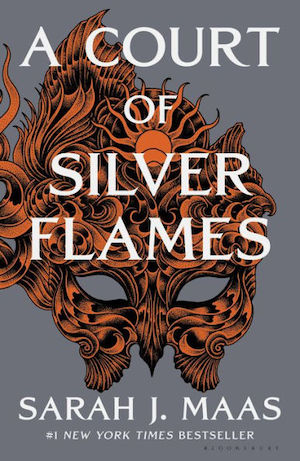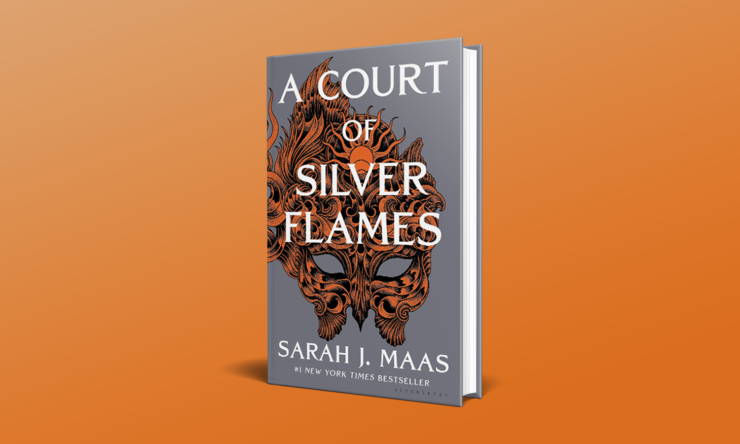Nesta Archeron has never been everyone’s favorite. When the eldest Archeron sister was introduced in A Court of Thorns and Roses, she was breathtakingly cruel. But when her little sister Feyre returned from the land of Prythian—the Faerie land where she’d been taken by a shapeshifting High Fae lord—it turned out Nesta was the only person who knew where she’d gone, and the only person who tried to follow.
While everyone else was taken in by stories about where Feyre went, Nesta saw through Fae glamour and spells, and was furious and alone in that knowledge. Nesta’s anger, over this and so many other things, blazed bright, and set her apart. What force of will allowed her to resist the magic that spelled pretty lies for everyone else? What would she do with all her fire and rage if she had her own magic, opportunity, a chance at another life?
What she did—what everyone did, in the first three Court of Thorns and Roses books—changed their world. But it also changed Nesta, who saw horrible things, did things she never thought she’d do, and became a wildly powerful High Fae against her will. Like other Sarah J. Maas heroines before her, Nesta arrives at her own book, A Court of Silver Flames, with baggage and trauma and so much to work through—as well as a smoldering will-they-won’t-they-obviously-they-will tendency to banter with a certain Illyrian warrior. At a chonky 700+ pages, Silver Flames is far more journey than destination.
The thing about this journey is that it seems to lose sight of Nesta along the way.
In A Court of Frost and Starlight, the short ACOTAR book that serves as a sweet coda to a terrible war, Nesta wasn’t okay yet. She wasn’t ready to play nice, to act like everything was fine, to be comfortable with her own new skin. She was too furious to function. And that’s where we find her at the start of Silver Flames: drinking and screwing and trying to hide from the PTSD that’s chewing her up. It’s clear she needs change and she needs help—and she needs to learn to love herself, too.
Silver Flames’ strongest aspect is a lovely thread about self-acceptance, about accepting love and help and how sometimes the best way to help a person is to be there with them, silently, while they find their way into healing. It’s clear that Maas is invested in the very idea of healing, of working through trauma, of doing the work yourself and also learning to let people help. But the thing that sets the plot in motion is so overbearing and patronizing that it colors everything that comes after. After a night where Nesta spends too much of their court’s money (an absurd thing to be the final straw, but fine) Feyre and Rhysand give Nesta an ultimatum. She can go live in Rhys’s mountaintop House of Wind (accessible only by magic, wings, or a ten-thousand-step staircase), where she’ll train with superstar Illyrian warrior Cassian in the mornings and work in the underground library in the afternoon. If she refuses, she will be sent back to the human lands alone.
Buy the Book


A Court of Silver Flames
It’s no choice at all, it’s not specific to Nesta’s needs, and it’s a rotten thing to do. (Side note, what happened to Feyre’s art therapy school?) It’s how they’ve always treated Nesta: she aches and acts out, and they see only her behavior, not the source of her pain. But the truly chafing thing is, of course, it works. This patronizing prescription of strenuous exercise and hard work is the catalyst for Nesta’s course-correction.
To be fair, it’s not that simple, and there’s a lot more to this story—more, and better, parts of Nesta’s healing journey. But there’s something uncomfortably unexamined in Feyre and Rhys’s treatment of Nesta—and in everyone else’s casual cruelty toward her (even Amren, who was helping Nesta understand her Cauldron-based powers not that long ago). It smacks of “We’re all fine and we lived through terrible things, so what’s wrong with you?” It’s part and parcel of how Rhysand is always right, a trend that becomes even more grating with a subplot involving a secret he keeps from Feyre. If you’ve read Kingdom of Ash, you will immediately guess why Rhys is behaving the way he does, but his aggressive protectiveness tips over into outright cruelty here, both toward his mate and toward Nesta.
This particular subplot dovetails frustratingly with Nesta’s story in a way that I shan’t spoil, not least because there are plenty of other things to discuss. But it made me think a lot about how Maas sets up her male characters. The good guys are super powerful, the most fierce warriors, the strongest, the most endowed. They also tend toward control and very traditional ideas of what masculinity is—but their more toxic traits exist in contrast to the truly sexist males, the traditional misogynists of Illyria who abuse and demean their females, and the brutes of the Autumn Court.
In contrast, Maas’s heroes look like gentlemen. But they are still centuries-old manchildren who have such possessive dominant needs that one of them can’t even keep his cool while the object of his affection dances with another male. It’s a politically motivated gesture. Everyone knows this. But it doesn’t matter; the jealous one just must cut in.
It can be hard to remember that these guys are supposed to be 500 years old.
Like Thorns and Roses, Silver Flames is both its heroine’s journey and a prologue to a much bigger battle, this one involving the remaining human queens who sided with the evil Hybern during the last war. One of them, craving immortality, was put into the Cauldron; she came out immortal but in the body of an old woman, and she’s deeply angry about this. On the one hand, fair—on the other hand, the only visibly old person in this book is a murderous crone whose evil tendencies are intrinsically tied to her new body. She’s the only queen to really matter in this plot, but there is a lot of spying and information gathering and background discussion of alliances and conflicts, all of which is clearly going to become foreground before too long.
Where Silver Flames shines is when it really belongs to Nesta—not to Rhys and Feyre, and not even to Cassian, who provides another perspective on, and element of, Nesta’s journey. Maas builds a separate life for Nesta, one where she has her own friends, shapes the direction of her own training, and rediscovers her own passions. These passions include steamy novels delivered to her by the magical House of Wind, which seems to share some of Nesta’s tastes. (The House may be my favorite character in this book.)
Nesta also shares her books with Gwyn, a priestess she befriends while working in the library, and Emerie, an Illyrian shop owner. Both have their own traumatic histories; both come slowly but then enthusiastically to join Nesta in battle training. Gwyn’s library background brings them ideas about “Mind-Stilling” (it would’ve been fine to just call it what it is: meditation, which they take to awfully quickly) and the legendary Valkyries, female warriors who died out in a battle long ago. Though they reach impressive fighting trim awfully quickly, there’s a lot of power in the sisterhood of fighters bringing new ideas to Cassian’s training, in doing the research to find Valkyrie techniques, in making their power their own.
Nesta, for much of the book, is all rage and pain and yet also determination; she will walk those ten thousand steps, she will convince the other women to come to training, she will show them—all of them. But what’s missing is that sharp nose for the truth, that steely certainty that served her well when Feyre first vanished into Prythian. There’s an inadvertent suggestion that Nesta’s personality is largely her trauma, and when she’s really solidly healing, her whole personality shifts. It’s too broad, too oversimplified. Earlier books in this series are also about trauma and recovery, but in a way that prioritizes acceptance. There’s no acceptance for Nesta until she fits certain ideas about how she should be, and that makes her story a little hard to swallow.
It’s worth noting that this series no longer being published with any pretense of being young adult novels. The males in them may still act like teenagers, but we’re in entirely adult territory when it comes to sex and relationships. There is a lot of sex in this book; some of it is hot and some of it is hilarious, and even if that’s unintentional, it’s not bad; sex is funny sometimes! People think things that make sexy sense inside their heads but not out in the world! I will never not think it’s funny how much emphasis Maas puts on the size of Fae cocks, but Nesta enjoys herself, and that’s what matters. Her relationship to sex shifts from a means of avoiding herself and her feelings to a source of release and connection and freedom. Her relationship with her own body is part of her healing, both in terms of fighting and in terms of sex, and it’s good to see her enjoy that.
In the end, I wanted to like A Court of Silver Flames so much more than I did. The endgame seems to be making Nesta as much as possible like everyone else. She can’t be a tavern-frequenting troublemaker and also a good person; she has to be a fierce warrior, embrace the details and intricacies of court life, learn to behave, take part in the unnecessary rituals, and play along with Rhys’s power trips and temper tantrums, or else she’s doing it wrong. Her new friendships provide a small sanctuary from this, but it’s clear that Nesta needs to get in line with a specific kind of heroine behavior. The way Rhys’s Inner Circle treats her until she does is little short of bullying. Even her relationship with Cassian—which builds slowly and steamily to an inevitable revelation—can only offer so much protection.
Yet there are gorgeous details, tiny moments that matter in Nesta’s development that stand out more than all the drama and the shitty male behavior: Nesta’s determination to make it down all ten thousand stairs in the House of Wind; the goofiness of Fae friendship bracelets; the minor characters whose presence I want to know so much more about, including the rest of the librarians. Maas teases bigger reveals, a redemption arc for a perhaps undeserving character, and a lot going on in the background—including what’s up with the miserable, unhappily-mated-to-Elain Lucien; the bespelled Vassa; and Jurian. Amren and Mor are underused, but it’s clear that Maas wanted to give Nesta her own life, separate from her sister’s court (though it would’ve been nice to do so without making both of those characters even meaner to Nesta than usual). There is grace and power in the strength that Nesta gains, both physical and mental, and there’s so much to admire in the patience Maas takes with Nesta, the time it takes for her to get comfortable, to make friends, to face some of the things that she’s been struggling with. It’s a difficult line to walk, making external forces relevant to—but not responsible for—emotional healing, and on that front, Maas succeeds.
A Court of Silver Flames is available from Bloomsbury.
Molly Templeton lives and writes in Oregon, and spends as much time as possible in the woods. You can also find her on Twitter.










